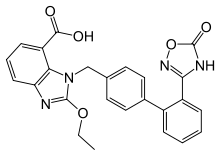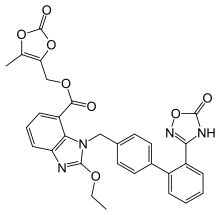Azilsartan
 | |
| Clinical data | |
|---|---|
| Trade names | Edarbi |
| Synonyms | TAK-536 |
| AHFS/Drugs.com | Consumer Drug Information |
| MedlinePlus | a611028 |
| License data |
|
| Pregnancy category |
|
| Routes of administration | Oral |
| ATC code | |
| Legal status | |
| Legal status | |
| Pharmacokinetic data | |
| Bioavailability | 60% |
| Metabolism | CYP2C9 |
| Elimination half-life | 11 hrs |
| Excretion | 55% faeces, 42% urine |
| Identifiers | |
| |
| CAS Number | |
| PubChem CID | |
| IUPHAR/BPS | |
| ChemSpider | |
| UNII | |
| KEGG | |
| ChEBI | |
| ChEMBL | |
| ECHA InfoCard |
100.235.975 |
| Chemical and physical data | |
| Formula | C25H20N4O5 |
| Molar mass | 456.46 g/mol |
| 3D model (JSmol) | |
| |
| |
| | |
Azilsartan (INN) is an angiotensin II receptor antagonist used in the treatment of hypertension, developed by Takeda. It is marketed in tablet form under the trade name Edarbi as the prodrug azilsartan medoxomil (INN).
Medical uses
Azilsartan is used for the treatment of essential hypertension in adults.[1]
Contraindications
Azilsartan must not be used with aliskiren, a renin inhibitor, in patients with diabetes as this increases the risk of serious adverse effects. Like other antihypertensive drugs acting on the renin–angiotensin system, it is contraindicated during the second and third trimesters of pregnancy.[1][2]
Adverse effects
Common side effects include dizziness, diarrhoea and eleveted levels of the enzyme creatine kinase. More serious reactions such as angioedema are rare.[1][2]
Interactions
No relevant drug interactions have been found in studies. Based on experiences with other drugs acting on the renin–angiotensin system, it is theorized that azilsartan could increase the toxicity of lithium and of other drugs increasing potassium levels, such as potassium sparing diuretics.[1][2]
Pharmacology
Mechanism of action
Azilsartan medoxomil lowers blood pressure by blocking the action of angiotensin II at the AT1 receptor, a hormone that contracts blood vessels and reduces water excretion through the kidneys.[1]
Pharmacokinetics
Azilsartan medoxomil is quickly absorbed from the gut, independently of food intake. Maximal blood plasma concentrations are reached after one to three hours. The liver enzyme CYP2C9 is involved in the formation of the two main metabolites, which are pharmacologically inactive; they are the O-deethylation and decarboxylation products of azilsartan. Elimination half life is about 11 hours. 55% are excreted via the faeces, and 42% via the urine, of which 15% are present as azilsartan and the rest in form of the metabolites.[2]
Chemistry

The drug formulation contains the potassium salt of azilsartan medoxomil (codenamed TAK-491), an ester of azilsartan's carboxyl group with the alcohol (5-methyl-2-oxo-1,3-dioxol-4-yl)methanol.[2] This ester is more lipophilic than azilsartan itself.
History
On 25 February 2011, the U.S. Food and Drug Administration approved azilsartan medoxomil for the treatment of high blood pressure in adults.[3] On March 8, 2012, Health Canada approved the drug for mild to moderate essential hypertension.[4] In India it was approved in early 2017. Azilsartan medoxomil 40mg/80mg Tablets "Indicated for the treatment of hypertension in adults patients, either alone or in combination with other antihypertensive agents"
References
- 1 2 3 4 5 Haberfeld, H, ed. (2015). Austria-Codex (in German). Vienna: Österreichischer Apothekerverlag. Edarbi-Tabletten.
- 1 2 3 4 5 Dinnendahl, V; Fricke, U, eds. (2012). "Arzneistoff-Profile" (in German). 2 (26 ed.). Eschborn, Germany: Govi Pharmazeutischer Verlag. ISBN 978-3-7741-9846-3.
- ↑ "FDA approves Edarbi to treat high blood pressure" (Press release). U.S. Food and Drug Administration. February 25, 2011. Retrieved 2011-03-01.
- ↑ Notice of Decision for Edarbi